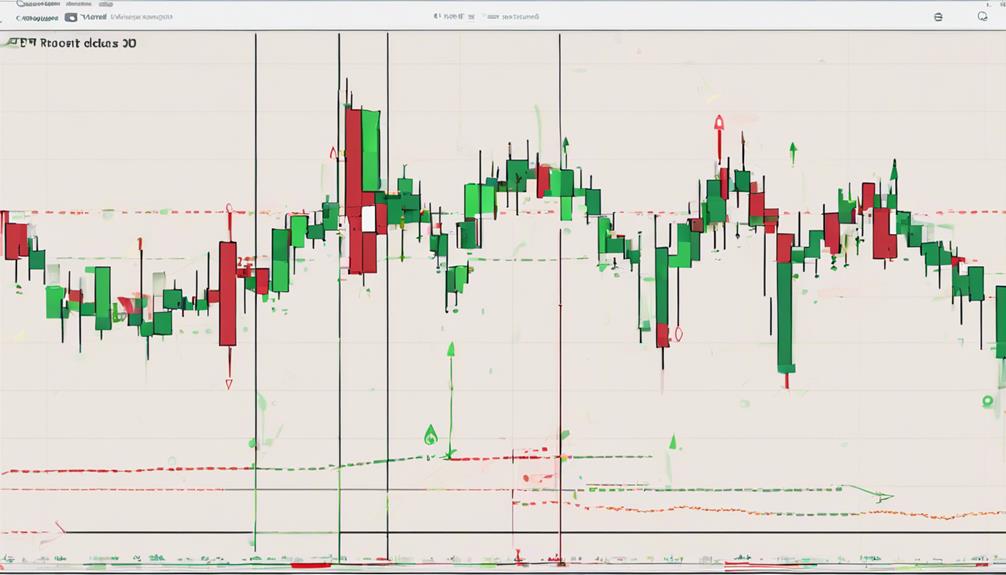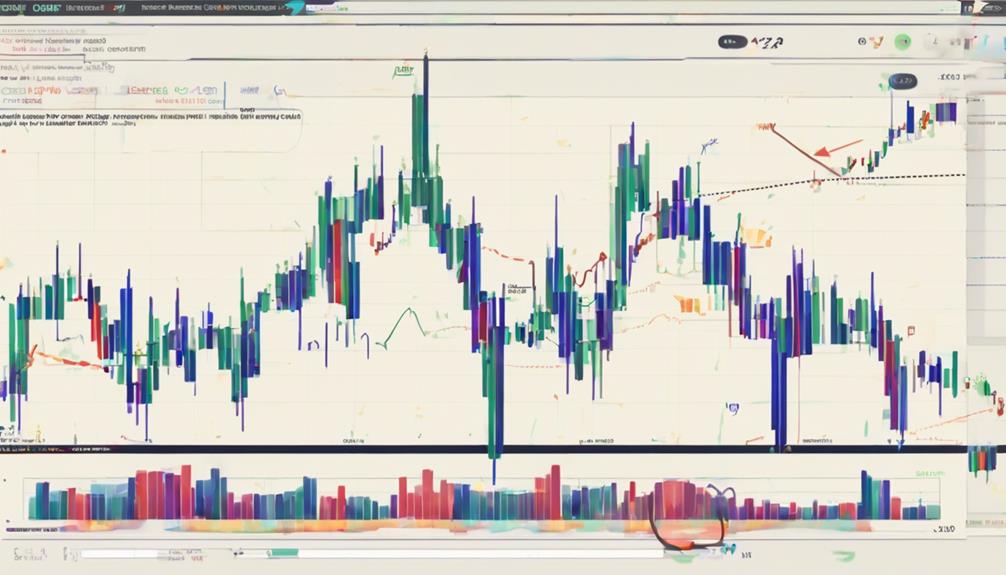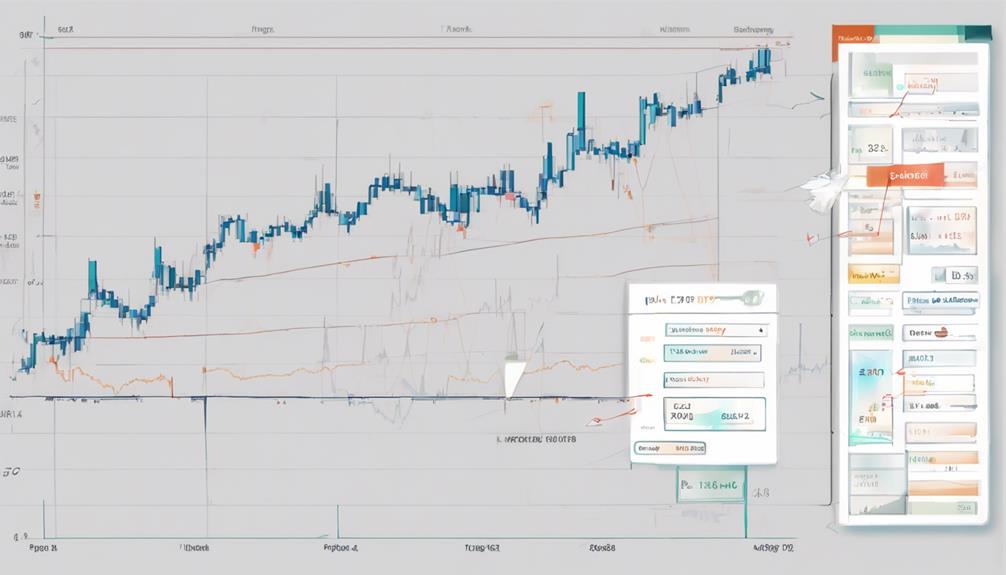For traders seeking to optimize their trading strategies, mastering the OBV indicator can be a game-changer. Understanding how OBV works and its predictive nature is crucial for making informed decisions in the market.
By combining OBV with other technical tools and analyzing trends effectively, traders can unlock a world of potential in their trading endeavors.
The key lies in developing a deep understanding of OBV's intricacies and nuances, which can lead to improved trading outcomes and profitability.
Understanding OBV Indicator Basics
The OBV indicator, a key tool in technical analysis, quantifies buying and selling pressure by tracking volume changes in the market. By incorporating volume into its calculations, OBV provides traders with a more comprehensive view of market dynamics than price alone. The relationship between OBV and price is crucial in understanding market trends.
When OBV rises in conjunction with price, it signifies a healthy buying trend, indicating potential price increases. Conversely, a falling OBV alongside price suggests increased selling pressure and a possible downtrend. Monitoring the balance between buying and selling pressure through OBV can help traders anticipate market movements and position themselves accordingly.
Additionally, divergences between OBV and price can serve as early indicators of trend reversals, offering traders valuable insights into potential trading opportunities. Understanding the basics of the OBV indicator is fundamental for traders looking to incorporate this powerful tool into their technical analysis arsenal effectively.
Interpreting OBV Signals Correctly

Interpreting OBV signals accurately is essential for making informed trading decisions based on volume dynamics in the market. When analyzing OBV signals, it is crucial to look for confirmation of price trends to determine optimal entry and exit points.
A rising OBV alongside a rising price typically indicates a bullish trend, signaling potential buying opportunities. Conversely, a falling OBV in conjunction with a declining price suggests a bearish trend, indicating a possible need to sell. Divergence signals between OBV and price should be closely monitored as they can indicate impending trend reversals.
To enhance the accuracy of OBV signals, traders often combine this indicator with moving averages to generate reliable buy and sell signals. Additionally, utilizing OBV crossovers, particularly in conjunction with key levels like the 20-period EMA, can help traders make effective trading decisions in alignment with the prevailing market sentiment, especially during bullish trends.
Implementing Effective OBV Trading Strategies

By integrating the On-Balance Volume (OBV) indicator into trading strategies, traders can enhance their decision-making process by leveraging volume dynamics alongside price action.
When implementing OBV trading strategies, traders should pay close attention to the correlation between OBV and price trends to confirm signals. Looking for OBV crossovers with key technical indicators like moving averages can provide valuable insights for identifying potential entry and exit points.
Additionally, incorporating secondary indicators such as Bollinger Bands can help filter signals, offering a higher level of trade confirmation. The OBV indicator's ability to quickly spot trends and potential reversals makes it a valuable tool in the market.
To maximize the effectiveness of OBV trading strategies, traders should consider combining OBV with other technical indicators to strengthen their overall strategy and improve their decision-making processes. By analyzing volume flow in conjunction with price action, traders can develop more robust trading strategies that capitalize on market opportunities effectively.
Maximizing Profits With OBV Indicator

Maximizing profits with the OBV indicator involves strategically leveraging volume dynamics to confirm trends, identify reversals, and enhance trading opportunities. To achieve this effectively, traders can:
- Combine OBV with moving averages: Utilize moving averages alongside OBV to generate more robust trading signals and confirm trend directions accurately.
- Watch for OBV crossovers: Pay attention to OBV crossovers with key levels like Exponential Moving Averages (EMAs) as they can provide entry points at optimal prices.
- Use divergence signals: Leverage OBV's divergence signals to anticipate potential market shifts early on, enabling traders to adjust their strategies proactively.
Avoiding Common OBV Trading Mistakes

To navigate the complexities of OBV trading successfully, traders must be vigilant in avoiding common pitfalls that can compromise decision-making and risk management. One prevalent mistake is relying solely on OBV for trading decisions without confirming signals with other indicators. Overlooking market context and trend analysis when using OBV as a primary signal is another pitfall to be mindful of.
Ignoring volume quality and solely focusing on OBV readings can lead to inaccurate trading decisions, increasing the risk of losses. Not considering market conditions and volatility levels when interpreting OBV signals can also result in adverse outcomes. Therefore, combining OBV with other technical analysis tools enhances accuracy and reduces the risk of trading errors.
How Can I Implement OBV Indicator Trading Strategies for Better Trade Performance?
Implementing trade performance enhancement with OBV indicator involves analyzing volume and price movements to identify buying and selling pressure. By using OBV trading strategies, traders can make more informed decisions and improve their overall trade performance. OBV can serve as a valuable tool for identifying trend reversals and confirming trade signals.
Frequently Asked Questions
How Do You Use OBV in a Trading Strategy?
In trading strategies, OBV serves to confirm trends by assessing its correlation with price movements. A rising OBV aligning with price indicates a bullish trend, while a falling OBV alongside price suggests a bearish trend. Divergence signals between OBV and price may hint at potential trend reversals. Combining OBV with moving averages can provide buy and sell signals to refine trading decisions. Integrating OBV with other technical indicators facilitates the swift identification of trading opportunities.
What Is the Best Time Frame for OBV Indicator?
The best time frame for the OBV indicator varies based on trading style and objectives. Swing traders often prefer the daily chart, while intraday traders find the 1-hour chart suitable. Short-term traders may opt for 15-minute or 30-minute charts, while investors might analyze weekly or monthly time frames.
How Reliable Is the OBV Indicator?
The reliability of the OBV indicator hinges on its ability to anticipate price movements and discern market player actions. When integrated with other indicators, OBV can provide valuable insights, enhancing trading decision-making and risk management strategies.
What Is the Formula for the OBV Indicator?
The formula for the OBV indicator involves adding volume on up days and subtracting on down days. It calculates the cumulative total of volume, reflecting the flow of volume in and out of a security by comparing current and previous day closing prices.
Conclusion
In conclusion, mastering the OBV indicator is crucial for successful trading strategies. By understanding its basics, interpreting signals accurately, and implementing effective strategies, traders can maximize profits and avoid common mistakes.
Just as a skilled sailor navigates rough waters with precision, traders who combine OBV with other technical analysis tools chart a course towards profitability in the volatile financial markets.
